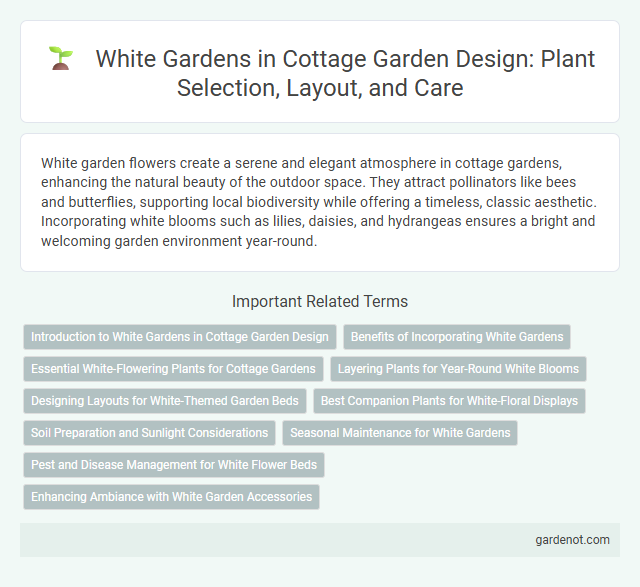White garden flowers create a serene and elegant atmosphere in cottage gardens, enhancing the natural beauty of the outdoor space. They attract pollinators like bees and butterflies, supporting local biodiversity while offering a timeless, classic aesthetic. Incorporating white blooms such as lilies, daisies, and hydrangeas ensures a bright and welcoming garden environment year-round.
Introduction to White Gardens in Cottage Garden Design
White gardens in cottage garden design create a serene and timeless atmosphere by using an array of white-flowered plants such as hydrangeas, foxgloves, and white roses. These gardens emphasize texture and foliage contrasts, incorporating silver-leafed plants like lamb's ear and dusty miller to enhance visual interest. The use of white blooms not only brightens shaded areas but also offers a tranquil backdrop that complements the informal, naturalistic style of cottage gardens.
Benefits of Incorporating White Gardens
White gardens create a serene and timeless aesthetic by emphasizing shades of white, cream, and silver, enhancing garden tranquility and visual coherence. They attract beneficial pollinators like bees and butterflies, promoting biodiversity and a healthy ecosystem. Incorporating white flowers also brightens shaded areas, extending garden enjoyment into evening hours with reflective petals that capture moonlight.
Essential White-Flowering Plants for Cottage Gardens
Essential white-flowering plants for cottage gardens include white foxgloves (Digitalis purpurea 'Alba'), which provide height and elegance, and Shasta daisies (Leucanthemum x superbum) known for their classic, bright blooms. Hardy white roses such as 'Iceberg' deliver continuous blooms and fragrance, while lily of the valley (Convallaria majalis) adds delicate ground cover with its sweet-scented bell-shaped flowers. Incorporating white campion (Silene latifolia) enhances texture and blooms profusely throughout the growing season.
Layering Plants for Year-Round White Blooms
Layering plants in a white garden creates a dynamic display of year-round white blooms by combining perennials, shrubs, and bulbs with staggered flowering periods. Utilize snowdrops and white crocuses in early spring, followed by white foxgloves and peonies in summer, and finish with white asters and hellebores in fall and winter. This strategic layering ensures continuous white floral interest, enhancing the classic cottage garden aesthetic.
Designing Layouts for White-Themed Garden Beds
White-themed garden beds in cottage gardens create a serene and elegant atmosphere using plants like Shasta daisies, white foxgloves, and fragrant white roses. Designing layouts emphasizes layering with varying heights, from low-growing white alyssum ground cover to taller white spirea shrubs, enhancing depth and texture. Incorporating soft curving paths and natural materials like weathered stone complements the all-white palette and maintains the garden's informal charm.
Best Companion Plants for White-Floral Displays
Best companion plants for white-floral displays in a cottage garden include lavender, which adds a fragrant purple contrast, and silver foliage plants like lamb's ear that enhance the white blooms with soft texture. Delphiniums and foxgloves provide vertical accents with their striking spires while maintaining a harmonious color palette. Hydrangeas, clematis, and snow-in-summer also complement white flowers by enriching the garden layers and seasonal interest.
Soil Preparation and Sunlight Considerations
White garden plants thrive in well-drained, fertile soil enriched with organic matter such as compost or aged manure to promote robust growth and vibrant blooms. Full sunlight exposure, ideally six to eight hours daily, is crucial for maximizing the intensity and longevity of white flowers. Selecting a site with balanced moisture retention and good air circulation prevents root rot and enhances the garden's overall health and aesthetic appeal.
Seasonal Maintenance for White Gardens
White gardens require seasonal maintenance to preserve their elegant, monochromatic appeal, emphasizing pruning white-flowering shrubs and perennials in early spring to encourage healthy growth. Regular deadheading of white blooms such as hydrangeas and daisies throughout summer promotes continuous flowering and prevents fading. In fall, mulching with organic matter protects roots and maintains soil moisture, while removing spent foliage prevents disease and prepares the garden for winter dormancy.
Pest and Disease Management for White Flower Beds
White flower beds in cottage gardens require proactive pest and disease management to maintain their pristine appearance. Common pests such as aphids, whiteflies, and spider mites can damage blooms, while powdery mildew and botrytis blight frequently affect white flowering plants like hydrangeas and lilies. Implement integrated pest management techniques including regular monitoring, natural predators, and appropriate fungicides to ensure healthy, vibrant white blooms throughout the growing season.
Enhancing Ambiance with White Garden Accessories
White garden accessories such as lanterns, ceramic pots, and trellises enhance the ambiance of a cottage garden by creating a serene and cohesive look. These elements reflect natural light, highlighting the lush greenery and delicate blooms while maintaining a crisp, clean aesthetic. Incorporating white seating and cushions adds comfort and elegance, transforming the garden into a tranquil retreat.
White garden Infographic

 gardenot.com
gardenot.com